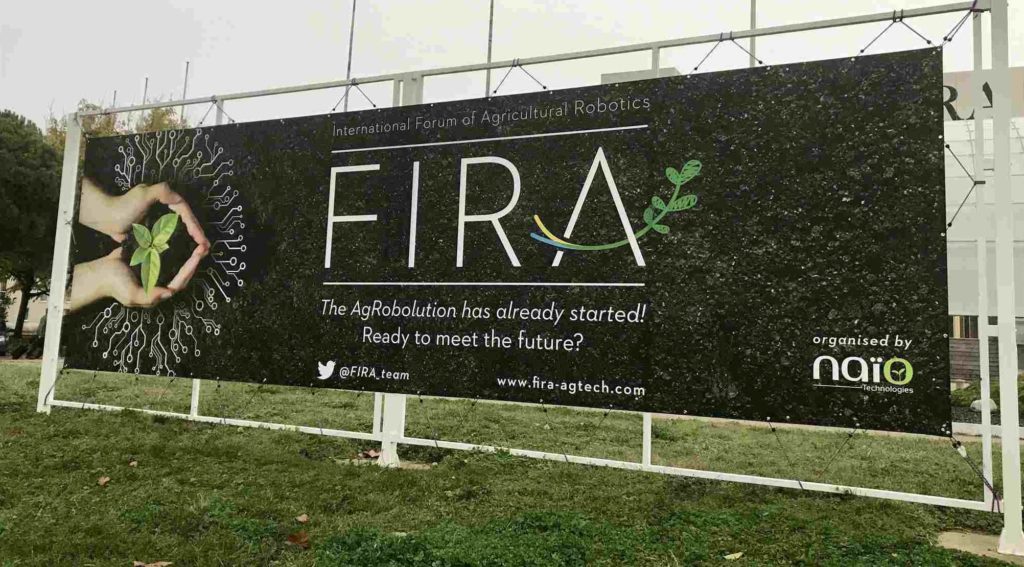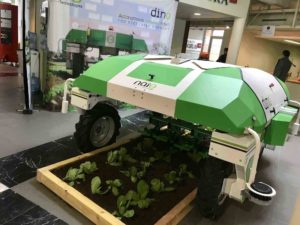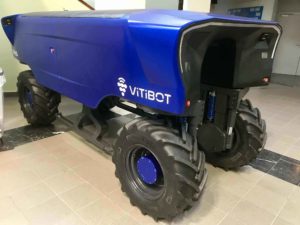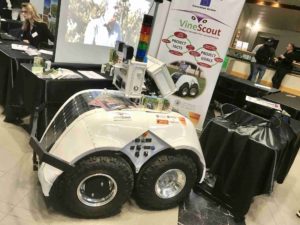FIRA Conference Points Up Ag Robotics’ Potential – and Challenges

The third International Forum of Agricultural Robotics (FIRA) in Toulouse, France offered an ideal venue for the robotics industry to showcase its latest technology — and prove its value.
In a clear sign that agriculture’s continuing adoption of robotics will have human as well as technological and logistical ramifications, protesters from France’s Yellow Vest (“gilet jaunes”) movement unexpectedly seized the stage of the third International Forum of Agricultural Robotics (FIRA) in Toulouse, France in December and held it for about 45 minutes until organizers and attendees shooed them off and resumed the conference.
The French protestors, carrying hand-painted signs reading “Farmers, Animals, No Robots” and “Unplug Them All,” used a conference microphone, their own megaphone, and finally their unamplified voices to hector an audience drawn from about 600 FIRA attendees hailing from more than 30 countries and five continents – a new record for the event following attendance of about 200 in its inaugural 2016 year and 400 last year.
If robotics’ potential to impact agriculture has attracted the attention of societal activists, it’s clearly done much the same among FIRA attendees, who represented both startups and larger tech and equipment companies as well as growers, consultants, financiers, suppliers of peripheral products, and others with a keen interest in robotics. Many marveled that application of ag robotics has picked up steam after years of sometimes hit-and-miss development and skepticism in the wider agricultural community – yet challenges still remain.
Moving Fast – and Still Often Confusing
Robotics, artificial intelligence, and machine learning are evolving so quickly, U.S. precision consultant Marc Vanacht noted, that his presentation at the conference was obsolete the moment he completed it. In addition to almost innumerable startup technologies adapted to regional and local uses, most new developments around the world still come from labs at national governments and universities, including projects reviewed by noted global robotics experts Prof. Salah Sukkarieh of the University of Sydney in Australia and Dr. Noboru Noguchi of Hokkaido University in Japan.
MORE BY JAMES C. SULECKI
How Chateau Ste. Michelle Harvests Two Grades of Winegrapes — from One Vineyard
There also are increasing numbers of corporate-funded technologies, Vanacht noted, including John Deere’s Blue River Technology and Bosch Deepfield Robotics’ Bonirob, both of which offer high-tech weed-control solutions. Still, “the American model of venture capital has not understood yet how important ag robotics are, or don’t feel comfortable with it, don’t know how to make money with it,” Vanacht said.
A panel of growers, even as they expressed hope for the potential of weeding robots to address problems in finding and paying workers and dealing with glyphosate’s somewhat uncertain future, said they were uncertain to varying degrees about how exactly widespread use of robotics might be integrated with their operations.
Alain Pincot, Managing Partner of Operations for Bonipak Produce, a vegetable producer in Santa Maria, CA, U.S., said his organization began using the Garford RoboCrop Inrow auto-weeder from the U.K. about seven years ago and has achieved about 75% control using it. The machine utilizes a camera to detect the crop and a computer to make decisions on which plants to keep or remove, then activates a kill mechanism.
Still, Pincot would like to have “more choices in terms of brands, more options and possibilities.” Robotics, at a cost of potentially hundreds of thousands of dollars per unit – plus the cost and use of tractors if the units are not autonomous – require growers to make very careful decisions. What if the machine breaks down – will growers have to make diagnoses themselves? Will service personnel be available by phone or able to come out to the farm within two or three hours? “We feel intimidated, and this is justified,” Pincot said. Bonipak has engineers on staff for maintenance and repair, but not all growing operations can afford this.
Pincot raised other issues including the management regimen necessary to plan the unit’s movement from field to field, and a need to redeploy workers from tractor-driven cultivation to a more automated process – typically at higher salaries, which often motivates drivers, and with training that is often supplied through the manufacturer.
Edouard Lhotte, a grower in France, said his own hesitation in using robotics included a lack of knowledge about the technology and how much it was likely to cost. And what about theft? Are units safe to be left in the field, operating day and night?
Weeders Are Most Popular
Nevertheless, choosing from among the major robot types that Vanacht identified – scouting, weeding, chemical application, and harvesting – growers had a clear preference for their “dream” robot: weeders. And indeed many of the most notable robots on display in FIRA’s small exhibit area are devoted to controlling weeds, including:
- Dino from Naïo Technologies in France is an autonomous unit guided by cameras and RTK guidance that straddles vegetable rows and mechanically weeds larger-scale cropping areas.
- Ecorobotix of Switzerland builds a solar-powered, fully autonomous “weed killer” robot that applies “micro doses” of herbicides at 1/20th of the normal volume according to Aurélien Demaurex, the company’s CEO and founder.
- The Bakus robot from VitiBot of France is designed to weed vineyards on slopes of up to 45 degrees using eight cameras and operating both day and night on a two-hour charge that lasts up to 10 hours. The first buyers of VitiBot are farmers in France’s Champagne region who will begin using the units early next year, said Cédric Bache, the company’s CEO.
But other there were other interesting robotics types on display. For instance, VineScout, developed by a consortium of organizations in Spain, Portugal, France, and the U.K., uses sophisticated sensors and machine learning to move autonomously from row to row of a vineyard in order to monitor a crop’s health.
And for greenhouse and nursery growers, InStar Robotics of France has developed Trooper, which can autonomously pick up and respace six nursery pots at a time, eliminating the need for workers to perform the repetitive and strenuous task. At an anticipated cost of 20,000-30,000 euros, the unit’s return on investment over the cost of labor is projected to be 2.5 to 3 years, according to Nicolas Schoemaeker, the company’s president.
Workerless Farms?
So what is to become of farm labor?
While the Yellow Vests’ concerns about workerless farmers were widely dismissed by FIRA attendees, researchers from the successful two-year Hands-Free Hectare project at Harper Adams University in the U.K. announced their next endeavor: the “Hands-Free Farm.” This will be a fully autonomous cereal operation working across multiple crops and fields using swarms of autonomous precision machines and remote agronomy.
“All of the equipment we use will be bought on eBay and Amazon to prove that this equipment is available to all,” said Jonathan Gill, a robotics engineer and Harper Adams researcher. And as with the Hands-Free Hectare, the goal of the Hands-Free Farm will of course be that no human ever enters the field.
But what will become of agronomists, whether “remote” or not? One attendee asked Gaëtan Severac, a co-founder of Naïo Technologies, about a common fear that artificial intelligence will replace consultants. “You can’t go against the general flow of society,” Severac said. “I think the job of consultants will change, but they will not disappear.”
Such are the continuing societal questions robotics developers will need to answer as the sector matures. Aymeric Barthes, Severac’s co-founding counterpart at Naïo, perhaps put it best when he said, “Robotics has to prove its value, as tractors did in the past. It is a long and hard way, but that is the challenge that we are choosing to take up. All of us in this place, and in this edition of FIRA – we are pioneers.”













